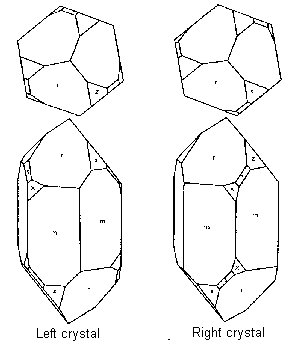Part of a series of articles titled Curious Collections of Fort Stanwix, The 19th & 20th Centuries.
Previous: Embossed Cornucopia Flask
Article
Several natural history artifacts were collected during the archeological excavations of the early 1970s at the site of Fort Stanwix in Rome, New York. Some of these materials were easily and accurately identified, but others were misidentified at the time of their collection. Archeologists study the material culture that humans leave behind and generally, do not have the knowledge to accurately identify geological specimen. The geologic objects uncovered by NPS archeologists can be grouped into three categories of curiosities, building materials, and sediments. The following describes two of the more interesting and uncommon curiosities.

NPS Photo
The first specimen identified as a curiosity is a sample of Quartz (SiO2). This artifact was originally described as a cut or worked piece of crystal quartz but is, in fact, a naturally occurring mineral sample. This mineral is a fine example of a “Herkimer Diamond” which is a naturally formed crystal of quartz with a pyramid-shaped structure on both ends.

Mason and Berry 1967
Herkimer diamonds are formed when groundwater seeped through buried dolomitic sandstone of the Little Falls geological formation. The Little Falls Dolostone formed in a shallow shoreline environment that was buried for millions of years and then compressed into rock (Isachsen, 2000). Quartz crystals like this are relatively uncommon and are found and collected locally near Middleville, NY. The first descriptions of Herkimer Diamonds can be found in scientific literature dating to 1819 and 1823 (Beck 1842; Moore, 1989: 6).
This artifact is a fossil from a species of coral commonly referred to as horn coral. Also known as Rugose coral, this specimen of horn coral likely formed in the shale deposits of the Skaneateles Formation, Hamilton Group, which is of Middle Devonian age (around 400 million years before present). In New York State, these fossils are most often found and collected along the east shore of Skaneateles Lake. Horn corals are found in rocks formed in a shallow, warm, marine shelf environment that is typical of a tropical sea bed below the wave base.

NPS Photo

Image courtesy of Rome Historical Society.
Both of these objects were found in areas not far from the rear of the Kingsley family home on Liberty Street. Dr. Willey Kingsley purchased the home in the 1861 and remodeled the house for his growing family in 1870. Two boys survived infancy (George and Willey J.) and both later followed their father in the field of medicine. In an 1878 image of the Kingsley family property a two story playhouse can be seen in the back yard.

NPS Photo
A contemporary description states:
The Playhouse, which has an interior stairway leading up to the second story where there are built-in display cases, which was reportedly used by the Kingsley boys for their rock and mineral collections and aquariums. (Waite, 1972: 28)
Could the Herkimer Diamond and the Horn Coral be curiosities from the boys’ collections that were shared with their friends and played with in the yard? Do you have your own ‘curiosities’ that you have collected?
Part of a series of articles titled Curious Collections of Fort Stanwix, The 19th & 20th Centuries.
Previous: Embossed Cornucopia Flask
Last updated: December 16, 2024